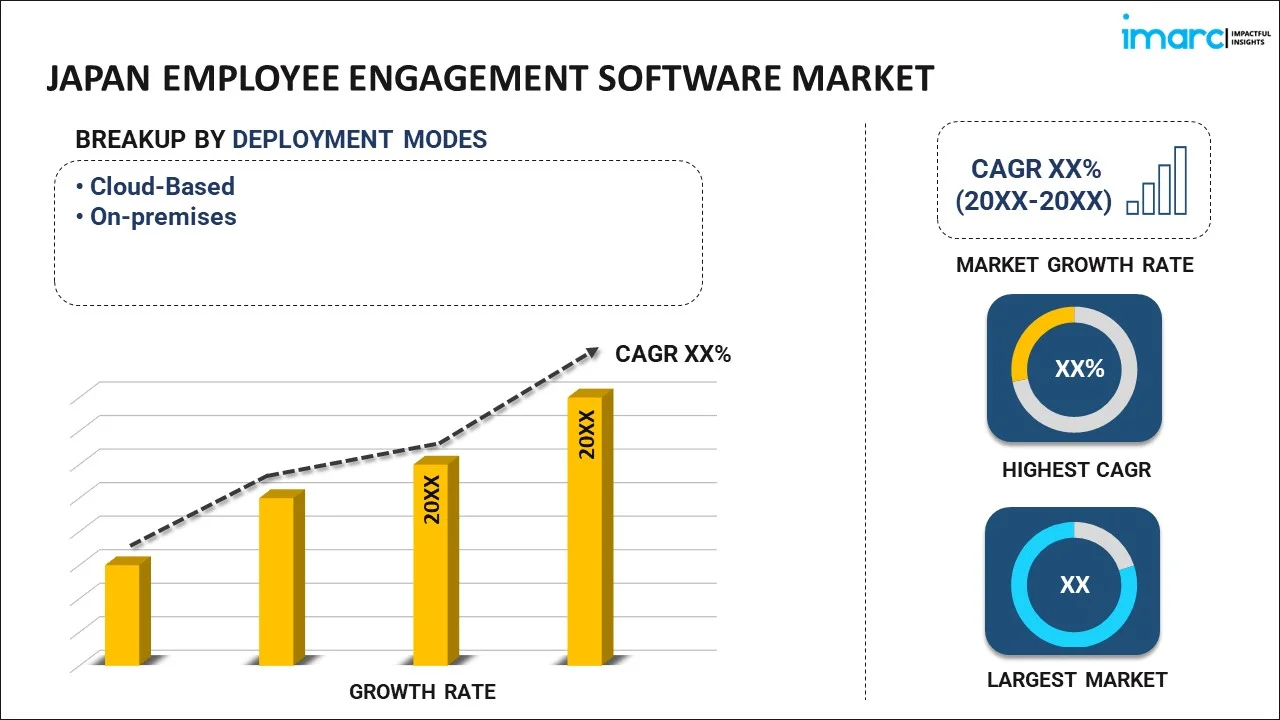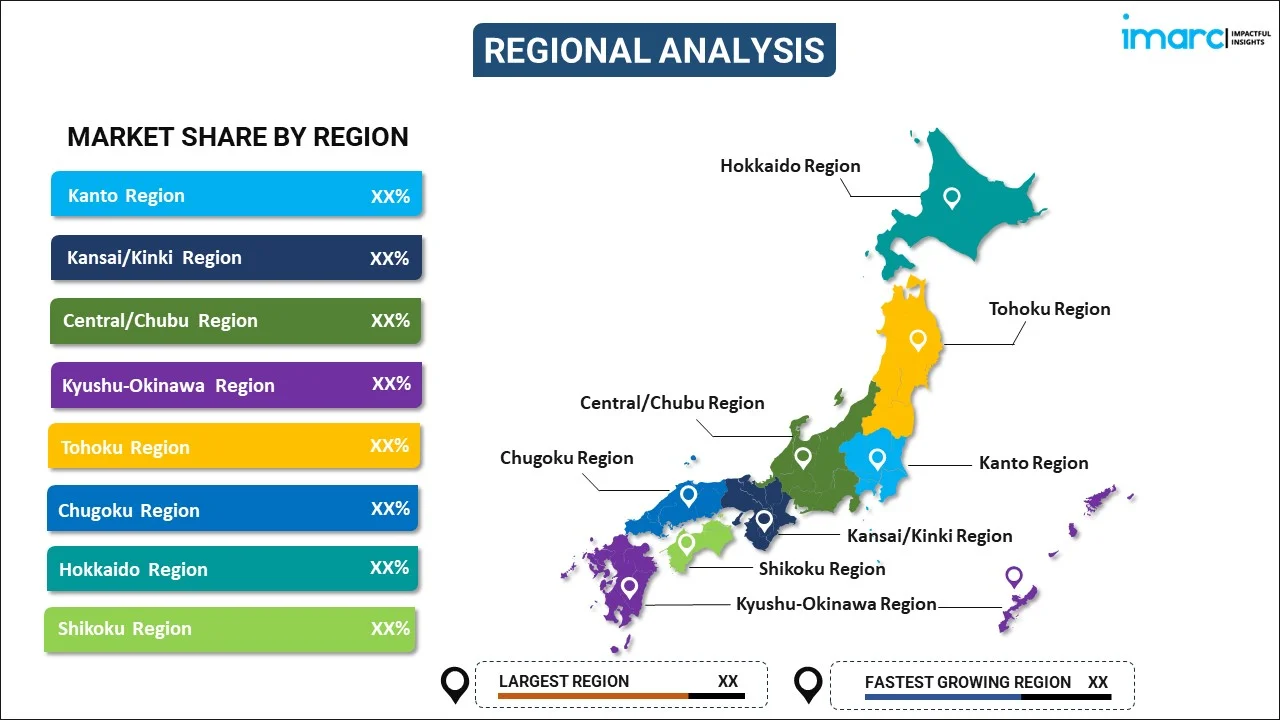
Japan Employee Engagement Software Market Report by Deployment Mode (Cloud-Based, On-premises), Function (Onboarding, Training, Collaboration and Interaction, Customer Service, Rewards and Recognitions, and Others), Industry (Retail, BFSI, Government, Healthcare, IT and Telecom, Hospitality, Manufacturing, and Others), and Region 2025-2033
Market Overview:
Japan employee engagement software market size reached USD 63.2 Million in 2024. Looking forward, IMARC Group expects the market to reach USD 254.0 Million by 2033, exhibiting a growth rate (CAGR) of 16.7% during 2025-2033. The significant expansion in the information technology (IT) and technology sector, the widespread adoption of employee engagement software in the manufacturing sector, and the growing product demand in the healthcare sector represent some of the key factors driving the market.
|
Report Attribute
|
Key Statistics
|
|---|---|
|
Base Year
|
2024
|
|
Forecast Years
|
2025-2033
|
|
Historical Years
|
2019-2024
|
|
Market Size in 2024
|
USD 63.2 Million |
|
Market Forecast in 2033
|
USD 254.0 Million |
| Market Growth Rate 2025-2033 | 16.7% |
Employee engagement software is an essential tool that organizations use to enhance the motivation, satisfaction, and productivity of their workforce. It is designed to measure and improve the level of engagement employees have with their work and the company. It is essential in modern human resource management and helps businesses create a positive and conducive work environment. It enables companies to collect valuable feedback from employees through surveys, feedback forms, and other interactive mechanisms. It allows organizations to gain insights into employee sentiments, concerns, and suggestions. It can track key performance indicators (KPIs), including metrics such as employee turnover rate, absenteeism, and participation in company activities. Additionally, organizations can identify trends and areas that need improvement by monitoring these indicators. Many of these software solutions offer tools for internal communication, knowledge sharing, and recognition programs, which help create a sense of belonging and teamwork among employees, essential for their engagement. Nowadays, employee engagement software often includes performance management features and allows managers to set goals, provide feedback, and track the progress of their team members, which promotes transparency and accountability within the organization across the country.
Japan Employee Engagement Software Market Trends:
The market is primarily driven by the growing information technology (IT) and technology sector. In addition, several tech companies are adopting employee engagement software to keep their tech-savvy workforce engaged, motivated, and connected, particularly during remote work, influencing market growth. Moreover, the widespread adoption of employee engagement software in the manufacturing sector due to its precision and efficiency while maintaining high levels of employee satisfaction and productivity represents another major growth-inducing factor. It also helps streamline communication and feedback mechanisms, ensuring that employees feel heard and valued. Besides this, the rising product use in the financial sector is attracting and retaining talent, creating a positive workplace culture, improving employee morale, and aligning teams with organizational goals, accelerating market growth. Along with this, the increasing use of employee engagement software in the retail sector, including e-commerce businesses, to aid retail organizations in managing their distributed workforce, ensuring consistent service quality, and improving customer satisfaction are propelling market growth. Also, the growing healthcare sector is using employee engagement software to support medical staff, reduce burnout, and enhance the overall patient experience, augmenting the market growth. Apart from this, rising educational institutions, such as schools and universities, are using employee engagement software tools to engage faculty and students in the learning process, which fosters a collaborative and effective educational environment, contributing to market growth.
Japan Employee Engagement Software Market Segmentation:
IMARC Group provides an analysis of the key trends in each segment of the market, along with forecasts at the country level for 2025-2033. Our report has categorized the market based on deployment mode, function, and industry.
Deployment Mode Insights:

- Cloud-Based
- On-premises
The report has provided a detailed breakup and analysis of the market based on the deployment mode. This includes cloud-based and on-premises.
Function Insights:
- Onboarding
- Training
- Collaboration and Interaction
- Customer Service
- Rewards and Recognitions
- Others
A detailed breakup and analysis of the market based on the function have also been provided in the report. This includes onboarding, training, collaboration and interaction, customer service, rewards and recognitions, and others.
Industry Insights:
- Retail
- BFSI
- Government
- Healthcare
- IT and Telecom
- Hospitality
- Manufacturing
- Others
The report has provided a detailed breakup and analysis of the market based on the industry. This includes retail, BFSI, government, healthcare, IT and telecom, hospitality, manufacturing, and others.
Regional Insights:

- Kanto Region
- Kansai/Kinki Region
- Central/ Chubu Region
- Kyushu-Okinawa Region
- Tohoku Region
- Chugoku Region
- Hokkaido Region
- Shikoku Region
The report has also provided a comprehensive analysis of all the major regional markets, which include Kanto Region, Kansai/Kinki Region, Central/ Chubu Region, Kyushu-Okinawa Region, Tohoku Region, Chugoku Region, Hokkaido Region, and Shikoku Region.
Competitive Landscape:
The market research report has also provided a comprehensive analysis of the competitive landscape in the market. Competitive analysis such as market structure, key player positioning, top winning strategies, competitive dashboard, and company evaluation quadrant has been covered in the report. Also, detailed profiles of all major companies have been provided.
Japan Employee Engagement Software Market Report Coverage:
| Report Features | Details |
|---|---|
| Base Year of the Analysis | 2024 |
| Historical Period | 2019-2024 |
| Forecast Period | 2025-2033 |
| Units | Million USD |
| Scope of the Report | Exploration of Historical and Forecast Trends, Industry Catalysts and Challenges, Segment-Wise Historical and Predictive Market Assessment:
|
| Deployment Modes Covered | Cloud-Based, On-premises |
| Functions Covered | Onboarding, Training, Collaboration and Interaction, Customer Service, Rewards and Recognitions, Others |
| Industries Covered | Retail, BFSI, Government, Healthcare, IT and Telecom, Hospitality, Manufacturing, Others |
| Regions Covered | Kanto Region, Kansai/Kinki Region, Central/ Chubu Region, Kyushu-Okinawa Region, Tohoku Region, Chugoku Region, Hokkaido Region, Shikoku Region |
| Customization Scope | 10% Free Customization |
| Post-Sale Analyst Support | 10-12 Weeks |
| Delivery Format | PDF and Excel through Email (We can also provide the editable version of the report in PPT/Word format on special request) |
Key Questions Answered in This Report:
- How has the Japan employee engagement software market performed so far and how will it perform in the coming years?
- What has been the impact of COVID-19 on the Japan employee engagement software market?
- What is the breakup of the Japan employee engagement software market on the basis of deployment mode?
- What is the breakup of the Japan employee engagement software market on the basis of function?
- What is the breakup of the Japan employee engagement software market on the basis of industry?
- What are the various stages in the value chain of the Japan employee engagement software market?
- What are the key driving factors and challenges in the Japan employee engagement software?
- What is the structure of the Japan employee engagement software market and who are the key players?
- What is the degree of competition in the Japan employee engagement software market?
Key Benefits for Stakeholders:
- IMARC’s industry report offers a comprehensive quantitative analysis of various market segments, historical and current market trends, market forecasts, and dynamics of the Japan employee engagement software market from 2019-2033.
- The research report provides the latest information on the market drivers, challenges, and opportunities in the Japan employee engagement software market.
- Porter's five forces analysis assist stakeholders in assessing the impact of new entrants, competitive rivalry, supplier power, buyer power, and the threat of substitution. It helps stakeholders to analyze the level of competition within the Japan employee engagement software industry and its attractiveness.
- Competitive landscape allows stakeholders to understand their competitive environment and provides an insight into the current positions of key players in the market.
Need more help?
- Speak to our experienced analysts for insights on the current market scenarios.
- Include additional segments and countries to customize the report as per your requirement.
- Gain an unparalleled competitive advantage in your domain by understanding how to utilize the report and positively impacting your operations and revenue.
- For further assistance, please connect with our analysts.
 Inquire Before Buying
Inquire Before Buying
 Speak to an Analyst
Speak to an Analyst
 Request Brochure
Request Brochure
 Request Customization
Request Customization




.webp)




.webp)












